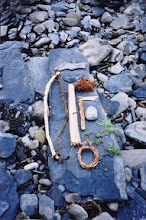
In the past two weeks, the weather here has been crazy. Sunny, balmy and close to sixty degrees F for one or two days, then the temperature plummets to fifteen degrees, followed by two days of cold rain. Then, six inches of wet snow, high winds and cold damp air around thirty five degrees. Then, back up to fifty or sixty.
It has been like this for a while, and it is typical of the late winter/early spring weather in the northeast. Most of us just throw another log on the fire, complain about the mud or slush and go on about our business.
However, to a person studying the skills of survival, it makes you think. "There's some fresh snow on the ground, no leaves or debris, and the snow is wet and melting fast. What should I do for a shelter?"
How do you predict the weather, and how much firewood should you gather? What sort of insulation could you find that will keep you warm and alive should you need to make your own shelter under these extreme conditions?
I can't tell you any formula that will work every time, and I can also add that this season is definitely for advanced students! However, here is some advice that might help, should you need it.
One: Always make sure your shelter can withstand a heavy snow load. This means building a strong framework, extra strong, actually, and try to double or triple your debris layer. Have you ever tried to lift wet snow when shoveling? It is really really heavy. So don't fool around when making your frame thick and sturdy!
Two: Gather materials when the weather is good. This is obvious, but it does tend to go against human nature. When the weather breaks, it seems like we should play, have fun, wander and explore. But you really have to buckle down and remember that tomorrow it could be super cold and windy, and you need to get firewood, grass, leaves, branches, whatever, just in case. Plan for the worst and hope for the best, is a good policy at this time of the year. Or, pay the price later, and I'm not talking about charging up your credit cards, baby.
Wool shirt-$70
Lakota Knife$125
Spending a night in a wet shelter, losing three toes to hypothermia-Priceless!
Ha ha ha, yeah, it's not so funny, is it?!!!
Three: You might have to travel to find a good location for a shelter. One thing to remember is that it is sometimes better to build a shelter in a location with lots of materials for firewood, debris, than to try to transport those materials to your 'preferred location'. Look for natural shelters, fallen trees, rocky outcropping, whatever you can use to protect you from the wind, the wet snow, and stay high and dry against flooding and water.
Four: Wear wool! Your gear is going to get wet, dirty, muddy, frozen and trashed. Make sure you have lots of dry gear to change into if you get wet too. Remember that fires are a pain when the wind is really blowing hard, in terms of smoke, sparks, firewood flaring up and burning three times as fast, etc.
Five: Be Careful! Snow is slippery. Slush is slippery. Mud, underneath the snow, is slippery. Wet logs underneath the snow/slush are very slippery. Tons of trees blow down at this time of year, and it is easy to get hurt if you start to get careless in the woods. Stay safe and have plenty of good, high energy foods to go along with the right gear and you can actually learn to enjoy this crazy time of the year. If you are out there, remember that the robins and other birds arriving early are having the same experience, so at least you have company!
I will be working on a book on Primitive Winter Shelters and Survival in this coming year, and should be filming a number of unusual shelters that are especially awesome for this time of year, so stay tuned! If you want to get involved in helping to build or film any of them, please let me know. I'll let you know more come November next year.
Enjoy this crazy spring weather!













No comments:
Post a Comment